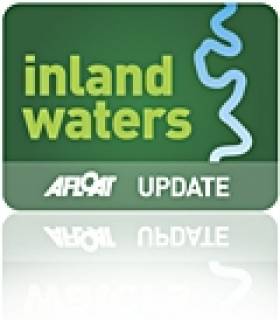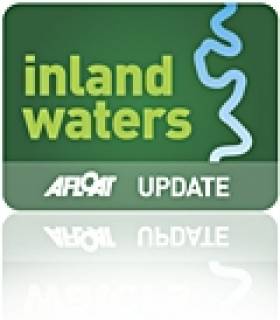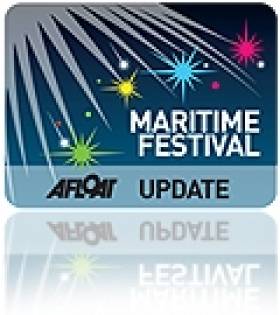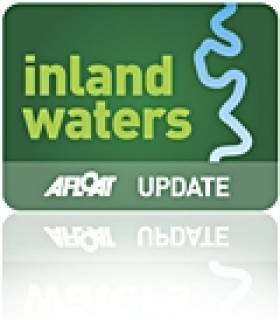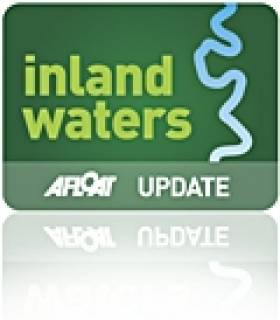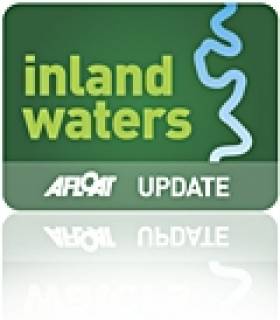Displaying items by tag: inland waters
Track Machine Owner Fined For Damage To Salmon River
#InlandWaters - A track machine owner has been convicted under Section 131 of the 1959 Fisheries Act for causing extensive damage to the bed of a tributary of the Nanny River in Co Meath.
Ronan Sheridan of Beshellstown, Co Meath was fined €500 and ordered to pay full costs of €1,555.56 to Inland Fisheries Ireland (IFI) by Judge William Hamill at a sitting of Drogheda District Court on 15 September last.
In November 2014, fishery officer Dr Maureen Byrne observed that Sheridan’s track machine had been used to divert river flows away from the natural course of the channel and permanently realign 80 metres of the Annesbrook River.
The river is a tributary of the Nanny, which supports wild Atlantic salmon and sea trout populations – species that have been the subject of a series of recently introduced conservation and protection measures from IFI.
Dr Byrne gave evidence outlining details of significant damage that had been caused to the bed of the river, which is a spawning and nursery habitat for Atlantic salmon and sea/brown trout. Sheridan was represented in court and pleaded guilty to the offence.
Commenting on the case, IFI's Dublin director Brian Beckett said there is a general prohibition under the Fisheries Acts from interfering with and damaging river and stream habitat.
He said that IFI continues to seek the assistance and co-operation of landowners as the primary custodians of the natural environment not to engage in works likely to impact on the fisheries and aquatic environment without prior consultation with them.
Beckett acknowledged the many landowners have made and continue to make contact with IFI to ensure that proposed works are undertaken in an environmentally sustainable manner.
IFI chief executive Dr Ciaran Byrne added: “Destruction of fish habitat is an environmental crime and must be prevented. Such destruction impacts the potential of rivers to contribute to our social and economic wealth.
"Recreational salmon and sea trout angling is estimated to contribute €210 million to the Irish economy and supports over 3,000 jobs. It is imperative that our fish habitat is conserved and protected to ensure the sustainability of this important natural resource.”
Lakelands Holiday Park Set To Put Longford On Tourism Map
#InlandWaters - An articificial lake will be the centrepiece of a new holiday retreat near Lough Ree, as The Irish Times reports.
Center Parcs' Longford Forest is set to go before planners next month, but the adventure village chain has already revealed its proposals for the 150-hectare site in Newcastle Wood near Ballymahon, Co Longford.
These comprise 500 chalets, including a number of treehouses, and amenities such as shops and restaurants situated around an artifical lake an an indoor "subtropical swimming centre".
The proposed location, owned by Coillte, is currently home to some 50 fallow deer that would have to be relocated to adjacent woodland during construction for the park, scheduled to open in 2019.
Meanwhile, Center Parcs says the vast majority of local people back its €100 million plans for Newcastle Wood, expected to boost significantly boost tourism to that corner of the Lakelands region.
And as Ronan McGreevy writes in The Irish Times, "it is hard to find anyone in Longford who is not enthusiastic about the prospect of Center Parcs coming to the county." More on the story HERE.
Waterways Draft Heritage Plan Open For Public Consultation
#InlandWaters - Waterways Ireland has completed the development of its Draft Heritage Plan 2016-2020 for Ireland's inland waterways and has opened it up for public consultation until 6 November 2015.
Developed in consultation with a wide range of stakeholders, the plan encompasses the cultural, built and natural heritage of the inland waterway corridors and aims to "identify, conserve and promote the sustainable use of the unique waterways heritage for the enjoyment of this and future generations."
It is focused on connecting people, communities and the wider population with their local waterway and fostering a sense of place
Heritage plan working groups gave generously of their time to develop this strategy, and it is hoped to deliver the plan in partnership with them.
Waterways Ireland says implementation of the plan will require involvement from across all sectors: Government, NGOs, businesses and local communities.
"Only through this co-ordinated approach can the waterways remain strong, vibrant places to live, each with its own local distinctiveness, offering a space for the public to stand and appreciate 'living heritage' in all its forms," said the body for Ireland's waterways.
To participate in the public consultation, first download the draft plan HERE.
Submissions are invited in writing either by post (to Draft Heritage Plan Consultation, Waterways Ireland Western Regional Office, Dock Road, Drewsborough, Scarriff, Co Clare V94 H7N1) or by email to [email protected] by 6 November 2015 and should include the name and address of the person/organisation represented.
Additionally, a series of public information sessions – as previously reported on Afloat.ie – will be held throughout this month and into October, and feedback given at these will be included with the formal submissions.
Waterways Ireland says all written submissions and comments received during the above time period will be considered and the draft plan will be amended accordingly.
Survey Your Local Waterway For Daubenton's Bat This August
#InlandWaters - 2015 marks the tenth year of the All Ireland Daubenton's Bat Waterway Survey – and Waterways Ireland and Bat Conservation Ireland are seeking volunteers across the island to take part in this year's survey over two nights in August.
Free training at a number of different centres began in June and will continue during July (for dates and details see HERE). This training will involve an indoor lecture followed by a practical session using bat detectors on a local river.
The survey is part a monitoring scheme recording the activity of the Daubenton's bat. These yearly surveys allow us to determine whether the population of this bat species is increasing or decreasing.
The more volunteer teams, the more accurate the information will be. In 2014, 252 waterways were surveyed across the island. Your help is needed to increase coverage for the island.
The Daubenton's bat is known as the water bat because of its preference to roost and feed close to water such as rivers and lakes. It is easy to identify because of all of our 10 species of bat, it is the only species that will be seen continuously skimming the water surface as it is feeding on insects.
Surveyors will be in teams of two people. Bat Conservation Ireland will provide the use of a bat detector for the survey. No prior experience is needed.
The All Ireland Daubenton's Bat Waterway Survey is funded by the National Parks and Wildlife Service (NPWS), the Department of Environment, Heritage and Local Government, and the Northern Ireland Environment Agency (NIEA).
If you would like more information or would like to register, visit the Bat Conservation Ireland website HERE.
Save The Dates: IWAI Lough Derg Rally 40, 11-18 July 2015
#InlandWaters - Waterways Ireland advises masters and owners of vessels that the Lough Derg Rally 40 will take place from Saturday 11 to Saturday 18 July 2015.
During that time the rally will visit a number of harbours on the Shannon Navigation, beginning with Dromann on Saturday 11 and Sunday 12, moving on to Terryglass on Monday 13 and Tuesday 14, anchoring out on Wednesday 15 for Shannonbridge on Thursday 16 before reaching Athlone for the final two days, Friday 17 and Saturday 18 July.
For more on the IWAI Lough Derg Rally 40 click HERE.
#Angling - Inland Fisheries Ireland (IFI) recently welcomed a visit from Dr Jed Wright of the US Fish and Wildlife Service, who is an expert in habitat assessment, protection and restoration programmes for Atlantic salmon in the Gulf of Maine.
During this visit, Dr Wright spent a day viewing weirs on the Rivers Nore and Slaney and was impressed by the "innovative" fish passage techniques used to support fish migration efforts over a number of these structures.
Following this, Dr Wright gave two informal talks dealing with riverine habitat restoration and barriers assessment in Maine.
Dr Cathal Gallagher, head of research and development with Inland Fisheries Ireland, said IFI "welcomed this important opportunity to share expertise in riverine and habitat restoration techniques.
"It is important that Ireland shares expertise in dealing with complex and difficult issues associated with restoration of damaged rivers and habitat. This is of particular importance when addressing Ireland’s commitments under the Water Framework Directive.”
Lough Erne Food Festival This Weekend
#MaritimeFestivals - The inaugural Festival Lough Erne is taking place in the island town of Enniskillen, Co Fermanagh this weekend – a celebration of food and the waterways with fun for all ages.
In the tented village there will be opportunities to meet local food producers and sample the very best of the area's produce, see guest chefs at work and pick up some informative cookery tips and recipes, all whilst tickling the taste buds.
Find out more about the festival's happenings today (Saturday 20 June) and tomorrow at the Fermanagh Lakelands website HERE.
#InlandWaters - The Shannon Blueway initiative received its second major award of the year at a star-studded event in Limerick's Thomond Park recently.
The European Sports Tourism Innovation Award was presented by Ireland's 6 Nations winning captain Paul O'Connell and Keith Wood of W2 Consulting to the Shannon Blueway partners Leitrim Tourism and Waterways Ireland at the prestigious European Sports Tourism Summit Awards on 14 May last.
Launched in October 2014, the Shannon Blueway is the first of its kind in Ireland where a myriad of recreational activities have been developed and bundled together as a single or multiple visitor experience and tourism proposition.
Waterways Ireland has developed and built a canoe trail from Drumshanbo through Battlebridge and Leitrim village to Carrick-on-Shannon. It has also developed a series of looped walks adjacent to the Lough Allen Canal, with plans to expand those walks to Drumshanbo and Carrick on Shannon.
At the same time, Waterways Ireland is also developing a canoe trail from Leitrim village along the 63km of the Shannon Erne Waterway with a walking and cycling trail also at an advanced stage of planning.
The wider Shannon Blueway, of which the Drumshanbo to Carrick-on-Shannon section is part, is at the heart of access to 100km of paddling area, six looped walks (three of which are on the canal towpath), two long-distance walks and three heritage trails. The blueway will ultimately provide access to 14 towns and services with each access point and town within an hours' paddling time.
The Shannon Blueway is being delivered by Waterways Ireland in partnership of the Irish Sports Council, Canoeing Ireland, Leitrim County Council, Leitrim Tourism and Fáilte Ireland.
Chief executive Dawn Livingstone confirmed that partnership was the key to delivering the Shannon Blueway.
"Waterways Ireland has invested significantly in creating world beating facilities and services on the Shannon Navigation and is delighted to see this initiative recognised with the European Sports Tourism Innovation award.
"Through our partnership with the National Trails Office, Canoeing Ireland, Leitrim Tourism and Leitrim County Council an outstanding multi-activity product has been built in the Shannon Blueway which is now being packaged by clubs and communities for their recreational activities and companies and organisations for domestic and international tourists. Partnership is key to delivering the future of the Shannon Blueway further into Leitrim and into Roscommon, Longford and Cavan."
Frank Curran, CEO of Leitrim County Council, said that the Shannon Blueway "represents an excellent product that has been developed through collaboration between Waterways Ireland and Leitrim County Council to facilitate the development of this signature tourism offering for Co Leitrim and the region."
The European Sports Tourism Innovation Award is the second prize this year for the inland waterways initiative, after taking the Best Tourism Initiative category of the 2015 Community and Council Awards in January.
#InlandWaters - Waterways Ireland is seeking contributions from the public on what they think best fulfils the theme 'Waterways Heritage'.
Participants of all ages are invited to enter the Heritage Art/Photographic Competition to be in with a chance to win an iPad Air.
Heritage of the inland waterways can include monuments, archaeological objects, heritage objects, architectural heritage, flora, fauna, wildlife habitats, landscapes and geology.
Entries should be of the waterways under the jurisdiction of Waterways Ireland, which include the Shannon Navigation, Erne System and Shannon-Erne Waterway; the Lower Bann Navigation; the Barrow Navigation; the Royal and Grand Canals; and the Ulster Canal (Upper Lough Erne to Clones).
The judges will select an entry (photograph, painting, sculpture, etc) which best captures the heritage of the inland waterways.
Entries will be divided into two categories: 18 years and over and under 18s. A prize of an iPad Air tablet will be awarded to the winner of each category.
Take the summer to prepare your entry and submit before the closing date for the competition, 30 September 2015. Terms and Conditions apply and details are included in the entry form HERE.
For further information and competition rules contact Sabine Browne of Waterways Ireland at 061 922 141 or [email protected]
#InlandWaters - Waterways Ireland has issued an advisory to customers on its navigations who have not yet complied with Canal Bye-Law requirements to purchase a Combined Mooring and Passage Permit (CMP).
CMPs cost €126 per year and permit the holder to cruise continuously and gain lock passage across all navigations from St Mullins in Co Carlow to Dublin and as far west as the Shannon Navigation.
Masters should note that vessels without a valid permit and/or not displaying the appropriate permit may in future be declined lock passage.
Masters and owners are requested to purchase their canal permits at the earliest opportunity to avoid disappointment when their cruising plans are interrupted.
Permits may be purchased from Shane Anderson, assistant inspector of navigation, at 087 286 5726 or [email protected]


























